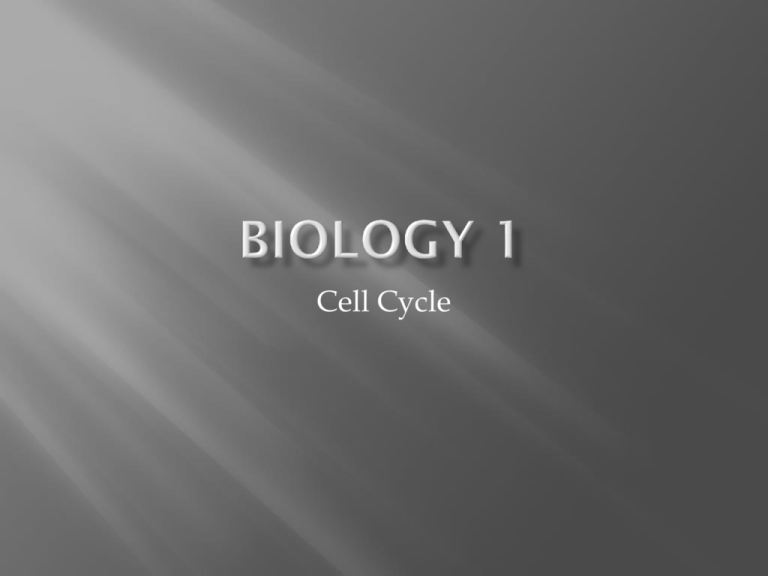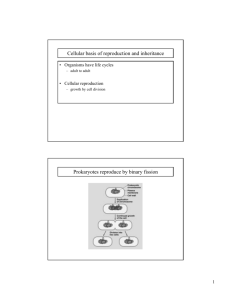7 Cell Cycle
advertisement

Cell Cycle Cell Theory: * All living things composed of cells * Cells are the basic units of structure and function in living things. * New cells are produced from existing cells Nucleus of the Cell: Controls most cell processes and contains the hereditary information. This is found as Deoxyribonucleic Acid (DNA) DNA: Coded instructions for making proteins. Chromatin: DNA bound to protein – granular and visible in the nucleus. Chromosomes: Chromatin that condenses in preparation for cell division. Microtubules: They aide in cell division, separating chromosomes (known as centrioles in animal cells). PROKARYOTE CELL DIVISION Cell Division called Binary Fission Asexual Reproduction DNA = One Circular Chromosome and Plasmids EUKARYOTE CELL DIVISION Cell Division called the Cell Cycle Growth and replacement of old and/or dying cells DNA = 10-50 chromosomes per cell Humans = 46 (23 identical pairs) Cell Cycle: Phase 1: Interphase G1 - primary growth phase S – synthesis; DNA replicated G2 - secondary growth phase Phase 2: Mitosis Phase 3: Cytokinesis Phase 1: Interphase G1 - primary growth phase Cell Matures: Growth and Organelles S – synthesis; DNA replicated DNA copied/replicated G2 - secondary growth phase Cell Structures needed for division made Centrioles Chromatin condenses into chromosomes Mitotic spindle forms and attaches to centromeres Nuclear membrane/nucleolus broken down. Centrioles dissolving Chromosomes line up at the equator of the cell Centriole Equator Centromere Centriole Sister Chromatids pulled apart to opposite poles of the cell. Equator Sister Chromatids completely at opposite poles Nuclear envelope forms Nucleolus appears Cytokinesis occurs Equator Phase 3: Cytokinesis Division of cell into two – Division of the cytoplasm by a cleavage furrow Cleavage Furrow Draw and Label the Following: • Interphase • Nuclear Membrane • Chromatin • Prophase • Centrioles • Nuclear Membrane (disappearing) • Chromosomes • Metaphase • Centrioles • Chromosomes • Mitotic spindle • Anaphase • Centrioles • Chromosomes • Mitotic spindle • Telophase/Cytokinesis • Chromosomes returning to chromatin • Nuclear Envelope forming • Cleavage Furrow 19 20 Early Anaphase Early prophase Metaphase Interphase Late Prophase Late telophase, Advanced cytokinesis Early Telophase, Begin cytokinesis Mid-Prophase Late Anaphase 21 http://www.youtube. com/watch?v=ZEwdd r9ho4&feature=related Karyotype A picture of the chromosomes from a human cell arranged in pairs by size First 22 pairs are called autosomes Last pair are the sex chromosomes XX female or XY male 23 The Y Chromosome Decides Y - Chromosome X - Chromosome 24 (Eggs and Sperm) Males: Spermatogenesis (formation of sperm) Females: Oogenesis (formation of eggs) Two Stages: Meiosis I and Meiosis II During Meiosis I – Homologs form Tetrads and crossing over occurs, all resulting cells are still diploid (2N) 46 chromosomes During Meiosis II – Chromosomes are split and all cells become haploid (1N) 23 chromosomes Entire process called reduction division Why is this important? Homologous chromosomes (compare to sister chromatids) Join to form a tetrad Called Synapsis (compare to a centromere) 26 Homologous chromosomes in a tetrad cross over each other Pieces of chromosomes or genes are exchanged Produces Genetic recombination in the offspring 27 Crossing-over multiplies the already huge number of different gamete types 28 Lets compare Mitosis and Meiosis – What do you know? 46 chromatids (92 chromosomes, paired after replication – held by a synapsis/centro mere) 46 chromosomes each side Mitosis: 46 chromosomes Meiosis: 23 chromosomes Mitosis Meiosis 2 Number of divisions 1 Number of daughter cells 2 4 Yes No Same as parent Half of parent Where Somatic cells Germ cells When Throughout life At sexual maturity Growth and repair Sexual reproduction Genetically identical? Chromosome # Role 31







